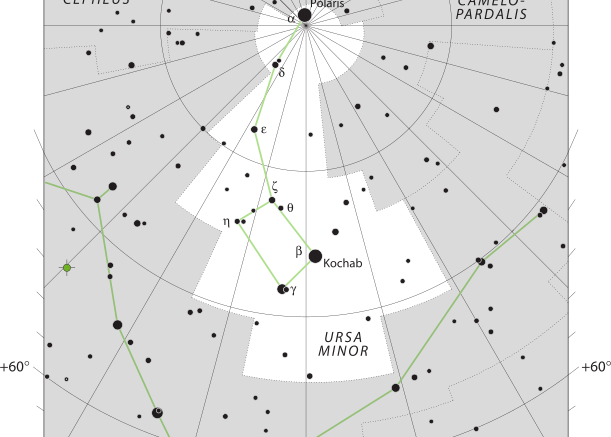Located in the northern sky, Ursa Minor which is Latin for “Lesser Bear”, is also known as the Little Bear. Like with Ursa Major, the tail of the Little Bear may also be seen as the handle of a ladle, which is why in North America, the name is the Little Dipper. It is made up of 7 stars with four in its bowl like its partner the Big Dipper. Ptolemy in the 2nd century listed the constellation as part of his 48 constellations. Ursa Minor has traditionally been important for navigation, by mariners, because of Polaris is the north pole star.
Covering 256 square degrees, Ursa Minor ranks 56th of the 88 constellations in regards to size.
Polaris, the brightest star in the constellation, is a yellow-white supergiant and the brightest Cepheid variable star in the night sky. Planets have been detected orbiting 4 stars.
| Applicable Information | |
| Visibility In Pacific Northwest | All year |
| Best Times To View | June |
| Right Ascension | 08h 41.4m to 22h 54.0m 08h 41.4m to 22h 54.0m |
| Declination | 65.40° to 90° |
| Area | 256 square degrees |
| Main Stars | 7 |
| Brightest Object | Polaris |
| Meteor showers | Ursids |
| Messier objects | 0 |
| Neighboring Constellations | Draco, Camelopardalis, Cepheus |
History
In the Babylonian star catalogues, Ursa Minor was known as the “Wagon of Heaven” and is listed in a catalog at 1000 BC among the “Stars of Enlil”—that is, the northern sky.
There are According to Diogenes Laërtius, citing Callimachus, Thales of Miletus “measured the stars of the Wagon by which the Phoenicians sail”. Diogenes identifies these as the constellation of Ursa Minor, which for its reported use by the Phoenicians for navigation at sea were also named Phoinikē.[6][7] The tradition of naming the northern constellations “bears” appears to be genuinely Greek, although Homer refers to just a single “bear”.[8] The original “bear” is thus Ursa Major, and Ursa Minor was admitted as second, or “Phoenician Bear” (Ursa Phoenicia, hence Φοινίκη, Phoenice) only later, according to Strabo (I.1.6, C3) due to a suggestion by Thales, who suggested it as a navigation aid to the Greeks, who had been navigating by Ursa Major. In classical antiquity, the celestial pole was somewhat closer to Beta Ursae Minoris than to Alpha Ursae Minoris, and the entire constellation was taken to indicate the northern direction. Since the medieval period, it has become convenient to use Alpha Ursae Minoris (or “Polaris“) as the north star, even though it was still several degrees away from the celestial pole.[9][a] Its New Latin name of stella polaris was coined only in the early modern period. The ancient name of the constellation is Cynosura (Greek Κυνοσούρα “dog’s tail”). The origin of this name is unclear (Ursa Minor being a “dog’s tail” would imply that another constellation nearby is “the dog”, but no such constellation is known).[10] Instead, the mythographic tradition of Catasterismi makes Cynosura the name of an Oread nymph described as a nurse of Zeus, honoured by the god with a place in the sky.[11] There are various proposed explanations for the name Cynosura. One suggestion connects it to the myth of Callisto, with her son Arcas replaced by her dog being placed in the sky by Zeus.[10] Others have suggested that an archaic interpretation of Ursa Major was that of a cow, forming a group with Bootes as herdsman, and Ursa Minor as a dog.[12] George William Cox explained it as a variant of Λυκόσουρα, understood as “wolf’s tail” but by him etymologized as “trail, or train, of light” (i.e. λύκος “wolf” vs. λύκ- “light”). Allen points to the Old Irish name of the constellation, drag-blod “fire trail”, for comparison. Brown (1899) suggested a non-Greek origin of the name (a loan from an Assyrian An‑nas-sur‑ra “high-rising”).[13]
Inuit astronomy had the 3 brightest stars as Nuutuittut “never moving;” however, the term is more frequently used in the singular to refer to Polaris alone.
Chinese astronomy has the main stars of Ursa Minor divided between 2 asterisms.
Stars
The German cartographer Johann Bayer used the Greek letters alpha to theta to label the most prominent stars in the constellation. Johann Elert Bode would add iota to phi to the list of prominent stars, but only lambda and pi remain in use. Within the constellation’s borders, there are 39 stars brighter than or equal to apparent magnitude 6.5.
The closest NGC object to the Northern Celestial Pole is NGC 3172 or Polarissima Borealis, which is a faint galaxy with a magnitude of 14.9.
NGC 6217 is a barred spiral galaxy that has been characterized as a starburst galaxy. It is undergoing a high rate of star formation compared to a typical galaxy and can be located with a 4 inch or larger telescope.
Meteor showers
With the parent body of comet 8P/Tuttle, the Ursids peaks between December 18th and 25th.
Make sure to check out other articles on the site, including a brief introduction to constellations, other constellation articles, and more!

Be the first to comment on "Ursa Minor"